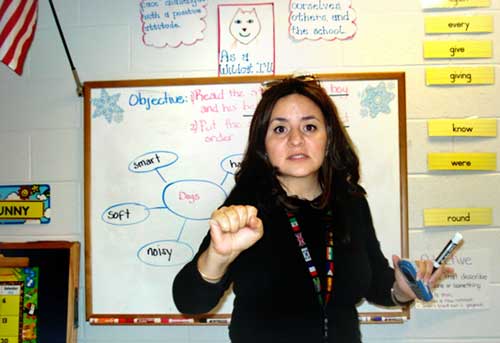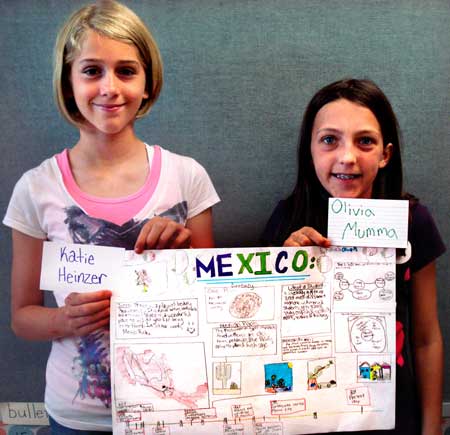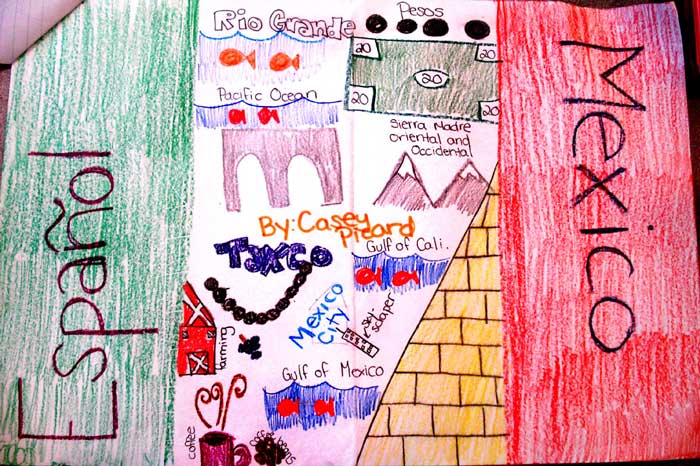|
By John Pint
 María
Luisa Salazar of Guadalajara teaches ESOL (English to
Speakers of Other Languages) at Buckland Mills Elementary School
in Gainesville Virginia, as a participant in an exchange visitor
program developed by VIF International Education, the largest
organization of its kind recognized by the U.S. State
Department. María
Luisa Salazar of Guadalajara teaches ESOL (English to
Speakers of Other Languages) at Buckland Mills Elementary School
in Gainesville Virginia, as a participant in an exchange visitor
program developed by VIF International Education, the largest
organization of its kind recognized by the U.S. State
Department.
“The school where I work has kids from China, Pakistan, India,
Korea and all over Latin America,” says Miss Salazar, “and my
job is to help them strengthen their skills in English and
succeed in the content areas.”
One day, Salazar asked the fifth-graders what they knew about
her native country, Mexico. “I was amazed at the response,” she
states. “I asked a lot of other kids at the school the same
question and inevitably, the very first things that came to all
of their minds were:
1. Sand
2. Heat
3. Cactus
4. Desert
I asked them what the people in Mexico are like and they had no
idea. It made me think. I know the weather around Guadalajara is
rather pleasant all year round and the city is surrounded by
hills covered in pine trees. ‘And what are we Mexicans like?’ I
asked myself. Well, I thought, in general we are pretty warm, we
like to talk, we like to be close to people and when we greet
them, we like that physical touch: we hug, we kiss. So I started
to look for ways I could give these children a better idea about
Mexico and Mexicans.”
Salazar happened to have a copy of our book
Outdoors in Western Mexico and sent me an email. “I really
would like the kids, and the teachers too, to see that Mexico is
not only about the bad news they hear on TV,” she wrote. “I want
them to experience a little bit of my beautiful hometown, and to
see a little more about the rest of the country,” and she asked
me where she could get more information about “the real Mexico”
to pass on to her kids. Among other things, I sent her a copy of
my PowerPoint called “The Magic
Circle” which depicts the extraordinary geo and biodiversity
around Guadalajara, where all five of Mexico’s ecosystems happen
to converge.
 “I
showed the slides to my kids and to all the other students in
the school,” says Salazar. “They were amazed. I showed them the
Colima Fire Volcano with red-hot lava pouring down its sides at
night, the gorgeous solitary beaches of Michoacán shimmering in
the sun, the huge monoliths of
El Diente, only ten minutes from the city. ‘I know these
places,’ I said; ‘I’ve been there.’ And when they saw a slide of
a little girl covered with mud (from the boiling mud pots of Los
Negritos), they were, like: ‘What’s going on there?’ And I said,
‘Don’t worry, that mud is healthy’ and they said, ‘Really?’ And
when they saw a big crocodile with its mouth wide open (at
San Blas) their eyes popped. Finally, I showed them the map
of Mexico where they could see that all five ecosystems come
together around Guadalajara, and they said, ‘No wonder!’ The
kids loved it and, by the way, so did the teachers.” “I
showed the slides to my kids and to all the other students in
the school,” says Salazar. “They were amazed. I showed them the
Colima Fire Volcano with red-hot lava pouring down its sides at
night, the gorgeous solitary beaches of Michoacán shimmering in
the sun, the huge monoliths of
El Diente, only ten minutes from the city. ‘I know these
places,’ I said; ‘I’ve been there.’ And when they saw a slide of
a little girl covered with mud (from the boiling mud pots of Los
Negritos), they were, like: ‘What’s going on there?’ And I said,
‘Don’t worry, that mud is healthy’ and they said, ‘Really?’ And
when they saw a big crocodile with its mouth wide open (at
San Blas) their eyes popped. Finally, I showed them the map
of Mexico where they could see that all five ecosystems come
together around Guadalajara, and they said, ‘No wonder!’ The
kids loved it and, by the way, so did the teachers.”
Marilú Salazar’s students then did their own research on Mexico
and prepared a Poster Presentation for Buckland Mills School
under the guidance of their hardworking normal teachers, Mrs.
Maraska and Mrs. Stroud.
“Mexico is a place of beauty and interest,” said fifth-graders
Katie Heinzer and Olivia Mumma in their poster. “It’s much, much
more than just a dry foreign country. It’s land with tropical
rain forests, sandy beaches and thriving cities. It is full of
culture, landmarks and activities. Mexico is a wonderful place
to visit if you like being entertained. In other words, Mexico
rocks.”
The information they gathered, of course, is seen through the
eyes of eleven-year-olds and might bring a smile to some of us
long-time residents of Mexico. For example, one poster tells us
“The most common animals in Mexico are jerboas, prairie dogs,
manatees, tree frogs, lizards and lots of poisonous snakes.”
Another fifth-grader’s research led her to the conclusion that
Mexicans are truly free people who can do whatever they set
their minds to and praises “Freedom, Mexican style.”
Marilú Salazar studied at the UDG and the Tec de Monterrey in
Guadalajara. One
day, at a convention of English teachers in Mexico, she walked
up to a representative of VIF International Education who was
sitting behind a table covered with brochures. She applied, and
not long after that she was interviewed by telephone, the first
step towards an overseas job which she has found deeply
rewarding.
VIF International Education—whose name means Visiting
International Faculty—was founded in the USA in 1987 by Dr. Fred
Young, “a lifelong proponent of international cultural exchange”
and his son Alan. VIF aims to help Americans gain global
awareness and cultural understanding. It would like to put at
least one international exchange teacher in every U.S. school to
help develop “globally literate citizens” who are proficient in
other languages. Over the years, VIF has sponsored 8,500
educators working in 1500 U.S. schools and they calculate they
have impacted one million U.S. students. The success rate of
these foreign teachers in U.S. schools is said to be 90 percent.
Recently VIF has expanded world-wide and now has
teacher-exchange programs in twenty countries, including
Denmark, Jamaica, Spain and Mexico.
I was impressed to discover that this organization charges no
fees and assists their teachers every step of the way, even to
helping them get housing and a car. If you know a Mexican
teacher who might like to have experiences like Marilú
Salazar’s, they should take a look at www.vifprogram.com .
My thanks for making this article possible to Janet Greer,
principal, and Jorge Neves, vice-principal of Buckland Mills
School, to Marilú Salazar and the other teachers there and most
of all to the children, some of whom, I have discovered, are
wise beyond their years…
“Before, I thought Mexico was all desert with cities here and
there; afterwards, I learned that Mexico is a diverse country a
lot like the U.S.—more so than either country realizes.”
–Noah Wong

|

